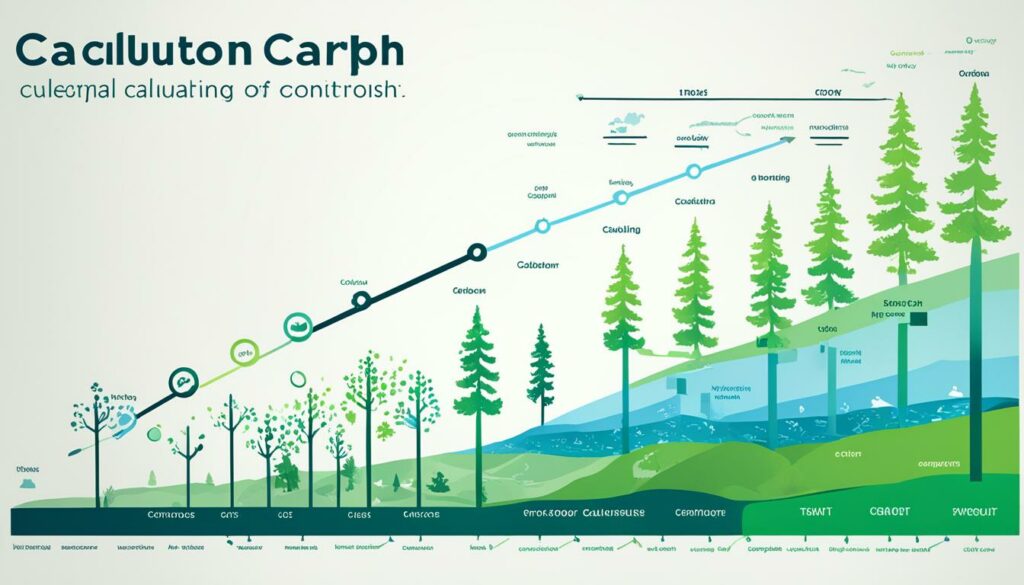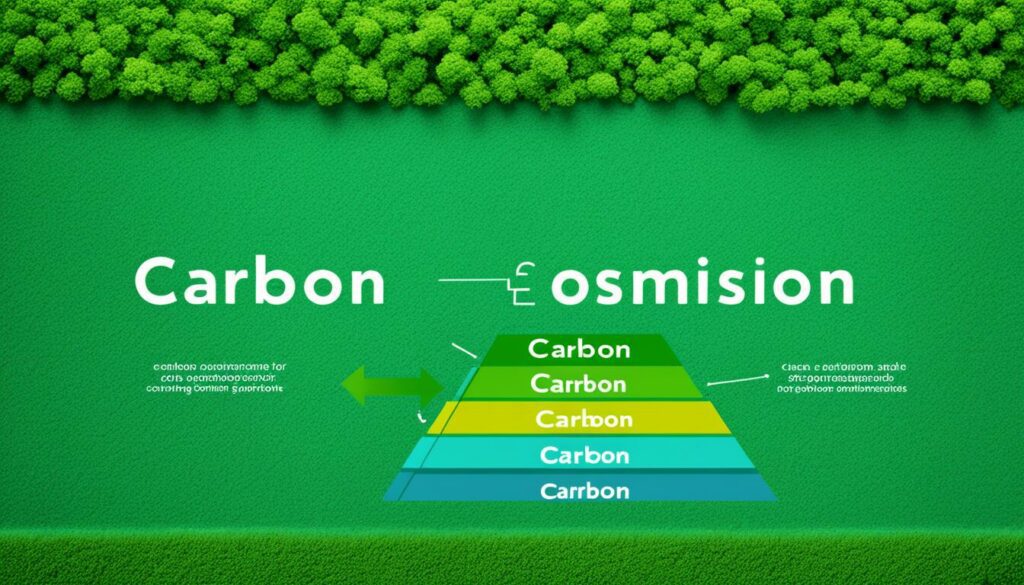Menu

Using a SaaS platform to check a company’s carbon footprint costs much less than hiring a consulting firm. Sustainability is becoming more crucial. Therefore, handling carbon emissions is vital. My expertise in ESG investment strategies helps investors and asset owners alike to manage carbon emissions.
I work in line with the European Commission’s advice for sustainable finance and the TCFD. I create educational guides to simplify carbon pricing. These guides help in designing investment portfolios aligned with the Paris Agreement. They also meet the TCFD standards and help in doing detailed environmental impact assessments.
Carbon footprint analysis checks the total greenhouse gas (GHG) emissions from something. This could be a company or a product. It helps us understand and fight climate change. By doing this, we can make smart plans to reduce our impact on the planet.
Carbon footprint analysis looks at GHG emissions, usually in CO2e form. It covers emissions from everything, like making things and moving them around. Doing a greenhouse gas emissions calculation is key for anyone wanting to be more green and meet climate targets.
It’s important for both people and companies. People check their direct emissions from things like using energy at home. And also, their indirect emissions from the stuff they buy. Companies use it to see where they can cut back and make effective climate change mitigation strategies.
The history of carbon footprints started with concern over the environment due to industrialization. Richer countries were watched closely because they had higher average carbon footprints per person. For example, in the U.S. in 2004, this was about 20.6 metric tons per person. Yet, compared to France with 6.0 tons, Brazil with 1.8 tons, and Tanzania with only 0.1 ton.
This difference sparked the use of methods like the Greenhouse Gas Protocol and ISO 14064 for assessing emissions. These ways have made it easier to push for eco-friendly practices review in big businesses.
| Country | Per Capita Carbon Footprint (2004) |
|---|---|
| United States | 20.6 metric tons |
| France | 6.0 metric tons |
| Brazil | 1.8 metric tons |
| Tanzania | 0.1 metric ton |
Thanks to our growing knowledge in this area, we can all make a real difference. Understanding our carbon footprint helps individuals and groups take actions. These actions aim to lessen our impact and work towards a healthier planet.
It’s key to know the various carbon footprints for a full environmental audit. They show where organisations are creating greenhouse gas (GHG) emissions. This information is vital for effective climate action.

An organisational footprint includes GHG emissions from a company’s activities. To measure this, companies use global standards like the GHG Protocol and ISO 14064. They calculate emissions by looking at consumption data and using emission factors. This approach covers both direct (Scope 1) and indirect emissions (Scopes 2 and 3). It helps organisations manage their total carbon output.
The supply chain carbon footprint looks at the carbon effects of what a company buys. It includes indirect emissions (Scope 3) from supplier activity and product transportation. Around 30% of US firms noticed their Scope 3 emissions in 2022. This highlights the growing concern around these indirect emissions.Actions like choosing products wisely and using green transport can cut these emissions a lot.
Then, there’s the product carbon footprint. It focuses on a product’s entire life, from making to disposal. The IPCC describes it as all the direct and indirect emissions throughout a product’s life stages. Companies are working on this, like Repsol aiming for net-zero emissions by 2050. Going for a circular economy can also help protect the environment, cut CO2, and boost sustainability.
The Greenhouse Gas Protocol Standard is a key way to look at emissions and their impact on the environment. Around 92% of big companies like those in the Fortune 500 use it to check their green efforts. By splitting emissions into different groups, it helps show a clearer picture of what’s going on.
Scope 1 emissions are direct, coming from things a company owns or controls. This includes gases like CO2, methane, and nitrous oxide. Cutting down on these emissions starts with adopting cleaner tech and using energy better.
Scope 2 emissions come from the energy a company buys and uses. Dealing with these emissions involves trying to use energy better and possibly moving to clean energy. The impact of the electricity and heat a company uses is important to consider.
Scope 3 emissions are lots of other types of indirect emissions in a company’s work. They can be from how employees get to work or from travel. Working with suppliers helps manage these emissions better.
The Greenhouse Gas Protocol Corporate Standard has 11 chapters and 4 appendices. They guide companies on how to find, measure, and lessen their emissions. Following these rules helps everyone work together for a greener future.
Calculating a carbon footprint is key for organisations that aim to cut carbon. It helps them understand the impact of their actions. And, it lets them start on sustainable projects.
At first, everything that emits gases is found. This includes what the company directly produces (Scope 1), like car emissions. Also, it covers what it uses (Scope 2), such as the electricity bought. And, it looks at broader impacts (Scope 3) from things like products it buys. This third part is tough but important. It makes sure all emissions are counted.
Next, data about these sources is collected. This means getting info on how much of each resource is used. Tools like Stream™ and Energy Manager™ are helpful here. They make measuring energy use and tracking emissions easier. Fossil fuels used for making electricity, heating, and moving things are big parts of the problem.

After collecting data, it’s turned into CO2 amounts. This step uses set formulas. It could involve timesing bills and values by specific numbers. This is how we find out where most emissions come from. And, it helps in planning how to reduce them.
Today’s tech makes this part much smoother. Using methods like ISO 14064 for issuing reports makes it more reliable too. So, companies can track their emissions well. They can also stick to environmental goals, even when cutting lots of CO2.
Tackling sustainability evaluation through carbon footprint analysis faces many hurdles. A big challenge is measuring Scope 3 emissions. This includes hard-to-track indirect emissions like staff travel.
A company in our case study faced big challenges with Scope 3 emissions. With operations in 14 states, calculating emissions was tough. They found that real estate activities created an environmental impact of 28,013 metric tons of greenhouse gases yearly.
Getting good data is also hard and crucial in carbon footprint analysis. The case study company worked hard to gather data from different parts of its supply chain. They started in 2019 due to the disruption caused by COVID-19, making it harder to keep data consistent in later years.
Different ways of measuring environmental impact also bring hurdles. The Greenhouse Gas Protocol splits emissions into three scopes. This can lead to counting emissions from things like a vehicle fleet twice if not watched carefully. In their case, emissions from vehicles added up to 7,524 metric tons, a large chunk compared to their building emissions.
The company used standards like GHG per Employee per year and GHG per $Million Sales per year to track their progress. But, a detailed look at the carbon footprint needs a close look. They followed the Bilan Carbone® method, approved by the French Ministry of Ecological and Solidarity Transition.
Looking at emissions specific to each sector adds to the challenge. Real estate, for example, releases 15 pounds of GHG per square foot every year. This shows that each industry has its own emission pattern, needing specific plans for sustainability evaluation.
There’s a crucial link between carbon footprints and climate change. Greenhouse gas emissions, mostly from human activities, are causing global warming. This warming is due to the greenhouse effect, which traps heat in the atmosphere. It’s a clear sign that we need strong actions against climate change.

The amount of carbon we’re putting in the air has grown a lot since 1961. Now, it makes up 60% of our total ecological impact. In 2022, the level of greenhouse gases in the air hit 523 ppm CO2 equivalent. This is much higher than what experts say is safe. If we don’t act fast, it could get 3 to 7 degrees hotter. This is way more than what the Paris Agreement wants.
“If current trends continue, atmospheric carbon dioxide could reach 75 billion tons per year by the end of the century, potentially leading to levels exceeding 800 ppm.”
Let’s look at some real examples of how emissions are affecting our planet. The amount of carbon we’re releasing from burning fossil fuels has gone up a lot. It was almost 11 billion tons in the 1960s and now it’s about 36.6 billion tons. Also, the amount of carbon dioxide in the air is rising by more than 2 ppm each year. In 2021, carbon dioxide was responsible for two-thirds of the heating effect of all human-made greenhouse gases.
Here is a comparative table that showcases the escalation of greenhouse gas emissions over the decades:
| Year | CO2 Emissions (Billion Tons) | Global Temperature Anomaly (°C) |
|---|---|---|
| 1960 | 11 | 0.2 |
| 2023 | 36.6 | 1.1 |
| Projected 2100 | 75 | 3-7 |
So, it’s really important that we act on this. We need to shift to clean energy and set tough targets to cut emissions. This is the key to fighting global warming and protecting our planet for the future.
Advanced tools and software are key in helping organisations track and reduce their carbon footprint. Companies like Persefoni and Microsoft Sustainability Cloud stand out here. Persefoni meets high standards including the GHGP and PCAF. It offers tools for tracking emissions, working together, using AI to spot errors, and creating detailed reports.
Microsoft Sustainability Cloud uses data and AI to help middle-sized companies with their green goals. Net Zero Cloud by Salesforce makes it easier to handle data for emissions accounting. This assists in cutting emissions. IBM’s Environmental Intelligence Suite helps by analysing climate risks.
Sphera is good for those seeking to improve ESG performance and risk management. Their platform focuses on safety and boosting environmental image. On the other hand, Sinai Technologies has tools to help companies lower their emissions while increasing growth.
Cohesive solutions like Emitwise help manage data for reducing carbon emissions in supply chains. They’re vital for moving towards a zero-carbon future.
Greenly targets small and medium-sized companies. It links solutions for tracking carbon with other platforms for better effect. The Carbon Footprint Analysis Tool, for example, estimates energy and emissions. It works with cloud providers like AWS and Google Cloud. This tool shows emissions visually and suggests how to lower them. It also lets you closely watch these efforts and see the expected benefits in terms of planting trees to offset emissions.
| Software | Primary Focus | Key Features |
|---|---|---|
| Persefoni | Emissions Tracking | GHGP & PCAF alignment, collaboration tools, AI error detection |
| Microsoft Sustainability Cloud | Sustainability Efforts | ESG tools leveraging data and AI |
| Net Zero Cloud | Decarbonisation | Data automation and integration |
| IBM Environmental Intelligence Suite | Carbon Accounting | Climate risk analytics |
| Sphera | ESG Performance | Centralised reporting and management |
| Greenly | Small Businesses | Third-party data platform integration |
With these tools and software, organisations can do a thorough carbon footprint analysis. This helps them become more eco-friendly in their operations.
Carbon footprint analysis looks at the gases a business directly and indirectly releases. It shows this in carbon dioxide equivalents (CO2e). This process is key for making good sustainability plans.
It helps businesses see where they make the most emissions. With this info, they can set better goals. They also learn how to reduce their impact in smart ways.

The fashion industry is a big area for carbon emissions. It involves a long supply chain and big production. Measuring its carbon footprint helps understand its environmental effects.
An in-depth analysis of carbon footprints has a few key steps. You start by deciding the scope, then you gather data. Next, you calculate the emissions.
After that, you interpret the data and create ways to cut emissions. This method follows rules like the GHG Protocol and ISO 14064. It makes sure the results are accurate and useful.
| Scope | Description | Examples |
|---|---|---|
| Scope 1 | Direct emissions from owned or controlled sources | Fuel combustion from company vehicles |
| Scope 2 | Indirect emissions from the generation of purchased energy | Electricity consumption |
| Scope 3 | All other indirect emissions within the company’s value chain | Raw material procurement, waste disposal |
Using carbon footprints helps companies make better choices. It guides them towards eco-friendlier operations. This way, they stand out for being responsible towards the environment. They can excel in a market that values green efforts more and more.
It’s key to understand carbon footprint analysis in various sectors. This helps identify exact emission sources. It leads to better environmental audits. Each sector brings something unique to greenhouse gas emissions. This affects their carbon footprint.
The energy sector is a big name in global greenhouse gas emissions. Here, making electricity and heat takes the lead. The focus is on cutting CO2 by changing how we use fossil fuels. In 2021, US homes using electricity caused 9.1% of the country’s emissions. Standby devices use up to 10% of a home’s energy, adding costs for families.
Transport and logistics also make a big impact, especially in the US. This is seen in private cars and trucks, hitting 1.05 billion metric tons of CO2 in 2021. A single car releases 0.77 pounds of CO2 per mile. The year saw 120 Mt CO2e from commercial flights and 35.2 Mt CO2e from trains. Emissions come mainly from vehicles, shipping, and using fuel. So, this sector is key for special carbon footprint studies.
The real estate sector deals with both how buildings run and their making. Building materials like cement and steel play a big role. They add a lot to the carbon footprint here. Between 1995 and 2015, materials’ production emissions rose by 120%. If most commercial roofs in the US had solar panels, it could lower emissions greatly. This is like not using 34 coal power plants for a year. This is why the real estate industry needs its own focus on carbon footprint.
Looking at these sectors shows why it’s important to study carbon footprints closely. This helps to make targeted plans for reducing emissions. It makes things more sustainable overall.
Businesses benefit greatly from looking at their carbon footprint. This study helps them be more efficient and kinder to the environment. Doing a sustainability evaluation shows them how to make big positive changes. Let’s look at what businesses get out of a detailed carbon footprint look.

Carbon footprint analysis boosts how effectively a business runs. It spots where in the business greenhouse gases are produced. Then, businesses can cut down on these emissions by focusing on smarter processes. This saves money and resources. For example, METech Recycling uses detailed data to show how much waste they divert from landfills. They even convert it into relatable metrics, like gallons of gasoline saved.
Taking sustainability evaluation seriously helps a business look good. Today, being eco-friendly matters more to over half of people than it did before—IBM showed this in 2022. Openly sharing your carbon footprint study results builds trust with everyone you work with or who uses your products. This makes you stand out in a positive way.
A detailed carbon footprint analysis is a big deal for following environmental laws. Companies worldwide must meet rules like those set by the EU (2014/95/EU), France’s “Grenelle II law,” and Germany’s “CSR Act.” Starting in 2025, the EU CSRD will make even more companies report on their efforts. Not following these rules can mean hefty fines, up to €20,000. So, sticking to the laws is very important.
Using carbon footprint analysis not only follows laws but also helps business grow sustainably. It improves how people see your company and keeps up with changing environmental rules. Always updating your study will show you’re a business that cares about the future.
By adopting efficient measures, you can significantly lessen your carbon footprint. This approach not only saves you money but also helps ensure a more sustainable future.
Using energy efficiently makes a big difference. For example, setting your water heater to 120˚F and adjusting the thermostat can save lots of energy. Remember to unplug appliances you’re not using to avoid wasting power.
Changing to LED or CFL bulbs from incandescent ones reduces waste and makes your bulbs last longer. Also, using low-flow showerheads and toilets, along with insulating windows, helps cut down on water and energy use.
Moving to renewable energy is key in reducing your carbon footprint. It means using sources like wind or solar power instead of traditional energy sources. This greatly cuts down your carbon emissions.
By getting a home energy audit, you can find ways to be more efficient. This step links saving money with helping the environment. Using renewable energy plans allows both homes and businesses to go green.
It’s important to minimise waste to reduce your carbon footprint. Ways to do this include recycling, using reusable bags, and giving away old clothes. This has a big effect.
Buying vintage or recycled clothes can cut down on manufacturing’s water and energy use. Choosing to buy less but better quality products also reduces waste. Supporting brands that care about the environment and buying carbon offsets are additional steps you can take.
Today, new technology is key in cutting down our carbon footprint. Businesses use these innovations to become more efficient and eco-friendly. This leads to big steps in sustainability.
The amount of carbon dioxide (CO2) in the air is now over 420 parts per million. This is up from 285 ppm long ago. To fight this, we need to make our use of energy better and turn to renewable sources.
Now, 40% of the world’s energy comes from renewable sources. Over 3300 gigawatts of power is produced from solar and wind. These numbers show a big change towards cleaner energy.

New tech is helping in many ways, like with more efficient machines and carbon storage systems. The digital world is as big a polluter as flying, so it’s important to use tech to cut emissions.
With AI and machine learning, we can predict and cut greenhouse gases more effectively. This means we can make smarter decisions to reduce our impact on the planet.
Chinese efforts to reduce CO2 emissions are a good example. They plan to hit their emissions peak by 2030 and be carbon neutral by 2060. Their hard work has already made a big difference.
From 2010 to 2020, the energy China used produced a lot less CO2. This is mainly thanks to better energy use and more renewable energy.
| Region | Innovation | Outcome |
|---|---|---|
| China | Energy Efficiency in Manufacturing | Reduction in Carbon Intensity to 1.98 by 2020 |
| Global | Integration of AI in Emission Forecasting | Enhanced Precision in GHG Calculations |
| Europe | Adoption of CCS Technologies | Significant Decrease in Industrial Emissions |
In Europe, carbon capture and storage (CCS) is making a big difference. It’s cutting down industrial emissions a lot. Also, using AI for predicting emissions is making our strategies to reduce carbon better and more accurate globally.
The future of looking at carbon footprints is really important. As we try to be more eco-friendly, knowing our carbon impact is a key part. Right now, the carbon footprint of people is a big part of our overall effect on nature. This has increased greatly since 1961. So, looking into how to measure our impact better is vital.
We need to review our green habits and how we check on the environment. It’s important to meet the goals we set in big deals like the Paris Climate Agreement. These goals aim to stop Earth from warming up too much. Even though we might not hit those targets, we can still push on. Improving how we measure our carbon impact helps us move in the right direction.
Adding new tech to check greenhouse gas levels will be a big step. The amount of these gases in 2022 was much higher than we should have. This shows we need better ways to keep track of lowering these gases.
New tools will make it easier to see how green companies and countries are. Switching to green power helps a lot. It lets us cut our big effect on the planet. Doing this can help us meet the global goals of the Paris Agreement.
Looking at homes and cars, they make a lot of the planet’s carbon use. So, we need to be very careful in checking on their impact. With the right steps, we can make these areas less harmful to the Earth.
To sum up, getting our carbon use figured out and improving how we do it is key. We must keep working hard. Only then we can try to lessen the bad effects of climate change.
The work on carbon footprints is key in fighting climate change. As we improve our tools, it’s clear there’s no one-size-fits-all method. We need to look at all six Kyoto gases and how they are used in vehicles. This makes sure we count all the pollution rightly.
A recent workshop at MIT showed us what matters when we judge our tools. Things like how much they cover, how exact they are, and if they compare well to other tools are really important. Tools that look at all transportation types are thought of most highly. Knowing how to set up tools that are both simple and powerful is key for going forward.
Businesses should use clear plans to check their carbon footprints. This means tracking energy use and how much vehicles drive. Given that 75% of electricity in the UK comes from fossil fuels, cutting down on energy use is critical. This includes the emissions from activities and the things they buy or use. Making sure the numbers we use are right is complicated but necessary.
Climate change is a big challenge that we all must face. Companies can play a big part by closely looking at their carbon footprints. This not only meets global goals like the Paris Agreement but also sparks new ways of doing business. By taking these steps, companies can be more efficient, creative, and known for doing the right thing.
Carbon footprint analysis looks at all the greenhouse gases (GHG) an entity or product releases. This study helps in understanding and reducing climate change impacts.
It lets businesses measure their environmental impact and set goals to reduce it. This improves how a business works and helps follow environmental laws. It’s key for making businesses eco-friendlier and fighting climate change.
Companies focus on three types. There’s the overall organisational carbon footprint, the one from their supply chain, and the specific footprint for their products.
The Greenhouse Gas Protocol splits emissions into three scopes. Scope 1 is direct emissions, Scope 2 is indirect from energy use, and Scope 3 is all other indirect emissions.
Problems include measuring indirect emissions (Scope 3), not having enough data, different methods, and counting emissions twice.
It shows how human activities and GHGs cause the greenhouse effect and global warming. This shows the need for strategies to reduce climate change.
Many tools and software are there to help with carbon footprint analysis. They make it easier to measure, manage, and cut down emissions for better environmental reports and audits.
It makes operations more efficient, improves the company’s image through green efforts, and keeps the business following environmental laws.
Good ways to cut down include becoming more energy efficient, using renewable energy, and creating less waste.
The energy sector looks at fossil fuel emissions. Transport and logistics focus on their vehicle emissions. Real estate checks its operations and building work emissions.
New tech is changing how we lower carbon footprints. It shows how advanced technology can calculate GHG emissions better and improve sustainability.
The future holds more precise reporting, new frameworks, and better technology. It’s all because of a push for sustainability and more demand for truth.